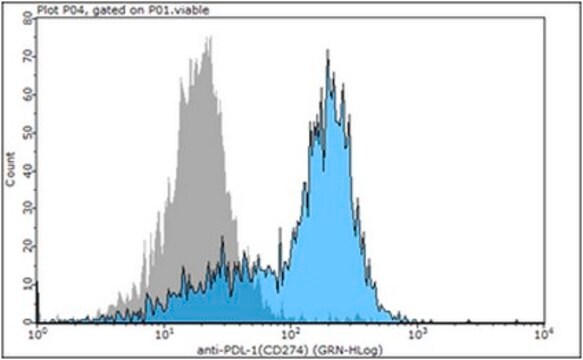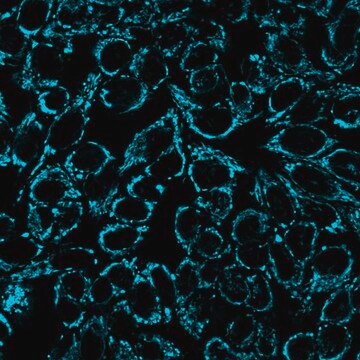APT142
MitoLight Mitochondrial Apoptosis Detection Kit
The MitoLight Apoptosis Detection Kit for flow cytometry utilizes a lipophilic cation, termed as MitoLight, as a mitochondrial activity marker.
Se connecterpour consulter vos tarifs contractuels et ceux de votre entreprise/organisme
About This Item
Code UNSPSC :
12161503
eCl@ss :
32161000
Nomenclature NACRES :
NA.32
Produits recommandés
Niveau de qualité
Fabricant/nom de marque
Chemicon®
MitoLight
Technique(s)
flow cytometry: suitable
Méthode de détection
fluorometric
Conditions d'expédition
dry ice
Description générale
Disruption of the mitochondrial transmembrane potential is one of the earliest intracellular events that occur following induction of apoptosis. The MitoLight Apoptosis Detection Kit utilizes a lipophilic cation, termed as MitoLight, as a mitochondrial activity marker. MitoLight is a mitochondrial dye that stains mitochondria in living cells in a membrane potential-dependent fashion. The monomer is in equilibrium with so-called J-aggregates, which are favored at higher dye concentration or higher mitochondrial membrane potential.
MitoLight partitions differently in healthy cells than in apoptotic cells. Therefore, it has been possible to use a fluorescence ratioing technique to study mitochondrial membrane potentials. In healthy cells, the dye accumulates and aggregates in the mitochondria, giving off a bright red fluorescence (λem = 585-590 nm). In apoptotic cells with altered mitochondrial membrane potential, the dye in its monomeric form stays in the cytoplasm, fluorescing green (λem = 527-530 nm), providing a ready discrimination between apoptotic and nonapoptotic cells. The fluorescence can be observed by fluorescence microscopy using a band-pass filter (detects FITC and rhodamine) or analyzed by flow cytometry using FITC channel for green monomers (Ex/Em = 488/530) and PI channel for red aggregates (Ex/Em = 488/585).
For research use only; Not for use in diagnostic procedures
MitoLight partitions differently in healthy cells than in apoptotic cells. Therefore, it has been possible to use a fluorescence ratioing technique to study mitochondrial membrane potentials. In healthy cells, the dye accumulates and aggregates in the mitochondria, giving off a bright red fluorescence (λem = 585-590 nm). In apoptotic cells with altered mitochondrial membrane potential, the dye in its monomeric form stays in the cytoplasm, fluorescing green (λem = 527-530 nm), providing a ready discrimination between apoptotic and nonapoptotic cells. The fluorescence can be observed by fluorescence microscopy using a band-pass filter (detects FITC and rhodamine) or analyzed by flow cytometry using FITC channel for green monomers (Ex/Em = 488/530) and PI channel for red aggregates (Ex/Em = 488/585).
For research use only; Not for use in diagnostic procedures
Application
Research Category
Apoptosis & Cancer
Apoptosis & Cancer
Composants
MitoLight (Part No. 71612): 25 μL in DMSO.
10X Incubation Buffer (Part No. 71614): 20 mL.
10X Incubation Buffer (Part No. 71614): 20 mL.
Stockage et stabilité
Store kit materials at -20°C up to their expiration date. After thawing, unused kit components can be refrozen. For best results, aliquot the MitoLight reagent into separate vials to avoid repeated freeze/thaw cycles.
PROTECT REAGENTS FROM LIGHT.
PROTECT REAGENTS FROM LIGHT.
Informations légales
CHEMICON is a registered trademark of Merck KGaA, Darmstadt, Germany
Clause de non-responsabilité
Unless otherwise stated in our catalog or other company documentation accompanying the product(s), our products are intended for research use only and are not to be used for any other purpose, which includes but is not limited to, unauthorized commercial uses, in vitro diagnostic uses, ex vivo or in vivo therapeutic uses or any type of consumption or application to humans or animals.
Code de la classe de stockage
10 - Combustible liquids
Certificats d'analyse (COA)
Recherchez un Certificats d'analyse (COA) en saisissant le numéro de lot du produit. Les numéros de lot figurent sur l'étiquette du produit après les mots "Lot" ou "Batch".
Déjà en possession de ce produit ?
Retrouvez la documentation relative aux produits que vous avez récemment achetés dans la Bibliothèque de documents.
Les clients ont également consulté
Kolaviron protects apoptotic cell death in PC12 cells exposed to Atrazine.
Abarikwu SO, Farombi EO, Kashyap MP, Pant AB.
Free Radical Research null
Mahendra Pratap Kashyap et al.
PloS one, 6(3), e17757-e17757 (2011-03-30)
Monocrotophos (MCP) is a widely used organophosphate (OP) pesticide. We studied apoptotic changes and their correlation with expression of selected cytochrome P450s (CYPs) in PC12 cells exposed to MCP. A significant induction in reactive oxygen species (ROS) and decrease in
Notre équipe de scientifiques dispose d'une expérience dans tous les secteurs de la recherche, notamment en sciences de la vie, science des matériaux, synthèse chimique, chromatographie, analyse et dans de nombreux autres domaines..
Contacter notre Service technique









